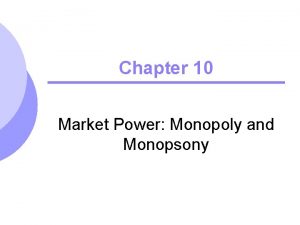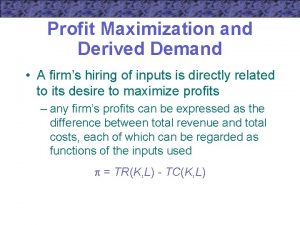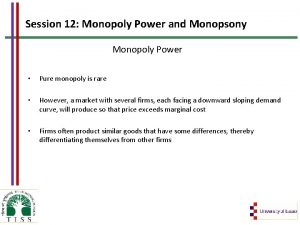Monopsony Power Topic 3 3 9 Monopsony Power













- Slides: 13

Monopsony Power Topic 3. 3. 9

Monopsony Power Topic 3. 3. 9 Students should be able to: • • Explain and evaluate the characteristics and necessary conditions for a monopsony to operate. Evaluate the potential costs and benefits of a monopsony to both firms and consumers.

What is Monopsony Power? • A monopsony has buying or bargaining power in their market. • This buying power means that a monopsony can exploit their bargaining power with a supplier to negotiate lower prices. • The reduced cost of purchasing inputs increases their profit margins • Monopsony exists in both product and labour markets

Examples of Monopsony Power • Electricity generators can negotiate lower prices for coal and gas supply contracts’ • Food retailers have power when purchasing supplies from farmers, milk producers, wine growers and other suppliers • A car-rental firm seeking a contract to a manufacturer to supply new cars for their fleet • Low-cost airlines getting a favourable price when purchasing a new fleet of aircraft • British Sugar buys almost the entire sugar beet crop produced in the UK year • Amazon’s buying power in the retail book market • The government is a major buyer e. g. in military procurement • The National Health Service is another example of a dominant buyer of prescription drugs from the pharmaceutical companies.

Recent Examples of Monopsony Power • Dec 2015: The UK is paying less for new cancer drugs than a number of other high-income countries, according to a report in The Lancet Oncology • Nov 2015: Brewing giant Carlsberg has told suppliers it is extend its payment deadline to 93 days, in breach of European guidelines • Nov 2015: Tata Steel has warned suppliers that if they don't cut prices by 30% they risk losing Tata's business • Dec 2014: Premier Foods, one of the UK's biggest food manufacturers, has been asking its suppliers for payments to continue doing business with the firm – this has become known as “pay to stay. ”

Benefits of Monopsony Power for Firms • Monopsony power allows bigger firms to achieve purchasing economies of scale leading to lower long run average costs • Lower purchase costs bring about higher profits and increased returns for shareholders • The extra profit might be used to find capital investment or research and development

Disadvantages of Monopsony Power • Businesses may use their buying power to squeeze lower prices out of suppliers. This reduces the profits of firms in the supply chain and can lead to lower incomes • Strong recent example has been the battle of milk farmers to get a price from supermarkets that covers the average cost of their milk • Paul Krugman has been critical of the monopsony power of Amazon in the book industry. – In October 2014 he wrote “Amazon is acting as a monopsonist, a dominant buyer with the power to push prices down. By putting the squeeze on publishers, Amazon is ultimately hurting authors and readers”

Benefits of Monopsony for Consumers • Consumers may gain from lower prices e. g. supermarkets can negotiate better prices from manufacturers that are then passed on to consumers • Improved value for money – for example the UK National Health Service can use its bargaining power to drive down the prices of routine drugs used in NHS treatments. Ultimately this means that cost savings allow for more treatments within the NHS budget • A monopsonist can act as a useful counter-weight to the selling power of a monopolist helping to protect the interests of consumers

Monopsony Power – The Milk Price Issue • Retail milk prices have been falling partly because of over capacity in the global milk industry and also due to supermarket price wars • Morrisons buys its liquid milk from Arla Foods and Dairy Crest, which is all supplied by British dairy farmers – the major supermarkets have monopsony power • Currently, the Arla co-operative pays a milk price of 23. 04 p/litre to its 12, 700 owners, including 3, 000 from the UK. Dairy Crest suppliers receive about £ 23. 3 p/litre for their milk. • Both farm-gate milk prices are roughly 7 p/litre below the average cost of production • In response to the crisis Morrisons has introduced a Milk for Farmers four-pinter, which pays dairy farmers a 10 p/litre premium

Average farm gate (producer) milk prices 35 data Average price in pence per litre 30 25 20 15 10 5 0 2003 2004 2005 2006 2007 2008 2009 2010 2011 2012 2013 2014 2015*

Revenue for Arla Foods 2014 Revenue share 0, 0% 10, 0% 20, 0% Fresh dairy products 50, 0% 60, 0% 20, 4% Cheese 17, 6% Non dairy products Others 40, 0% 51, 6% Butter and spreads Milk powder 30, 0% 7, 5% 2, 1% 0, 8% Arla Foods is a milk processing business and also a large producer cooperative. Arla’s stated mission is to secure the highest value for their farmers’ milk while creating opportunities for their growth. ”

How can milk producers lift their profits? Average yields per cow in the UK 9000 data 8000 6000 5000 4000 3000 2000 1000 /0 20 3 03 /0 20 4 04 /0 20 5 05 /0 20 6 06 /0 20 7 07 /0 20 8 08 /0 20 9 09 /1 20 0 10 /1 20 1 11 /1 20 2 12 / 20 13 13 /1 4* 0 20 02 Average yield in liters per cow per milk year 7000 • Agree long term price-supply contracts with milk buyers • Diversify into other products with premium prices • Improve productivity – i. e. higher yields from herds e. g. by better nutrition of cows • Form stronger producer cooperatives • Use technology to reduce feeding and milking costs • Grow their own forage to cut the variable cost of feed Many of the costs of milk production are fixed – therefore higher output from a herd leads to a fall in average fixed cost and a lower unit cost of supply

Monopsony Power Topic 3. 3. 9
 Monopsonyo
Monopsonyo Monopsony profit maximization
Monopsony profit maximization Monopsony
Monopsony A clincher sentence is
A clincher sentence is /topic/ down
/topic/ down Active power reactive power apparent power
Active power reactive power apparent power Presentation topics for students in hindi
Presentation topics for students in hindi Solar power satellites and microwave power transmission
Solar power satellites and microwave power transmission Actual power and potential power
Actual power and potential power Flex28024a
Flex28024a The dispersive power of a grating is defined as the :
The dispersive power of a grating is defined as the : Power of a power property
Power of a power property General power rule
General power rule Power angle curve in power system stability
Power angle curve in power system stability

























